Sandboarding in Peru
Qon: How can you turn sand into food, clothing, and shelter?
Answer: Conquer it on a board
Huacachina, a town forgotten by many guidebooks, sits hidden behind giant sand dunes. The dunes tower so high that they bring sunset to the town an hour early. It is a manufactured oasis that grows hotels, hostels, and restaurants, whose roots run deep within the lake, whose livelihood depends on this faux oasis and the draw of the dunes.
Our sandboards stood like picket fence posts along the disintegrating concrete wall. My long accompaniment with Andean ridges had been replaced by mountains of fine, wind-washed 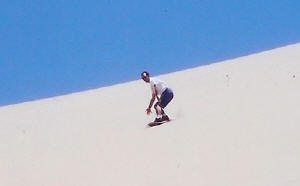 sand. These monoliths loomed over the oasis town of Huacachina like sentinels. An eternal wave break, the mountains of sand stood cresting to topple into the city, suffocating it.
sand. These monoliths loomed over the oasis town of Huacachina like sentinels. An eternal wave break, the mountains of sand stood cresting to topple into the city, suffocating it.
Like picking a profitable stock, we chose our sandboards from the many that stood fraying before us. "This one’s pretty," we thought, and took it for the best of the lot. Always one for 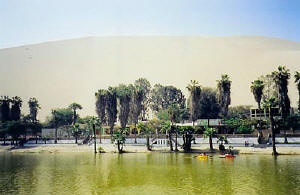 efficiency, I chose the board closest to me and picked it up as if it were roadkill. I turned it over in my hands wondering about the mechanics of it and carried my board like schoolbooks under one arm.
efficiency, I chose the board closest to me and picked it up as if it were roadkill. I turned it over in my hands wondering about the mechanics of it and carried my board like schoolbooks under one arm.
Others grabbed it by the straps, dangling it like a doll toted by a toddler holding onto only its stuffed leg. Waiting for us was a do-it-yourself dune buggy, painted in Rasta colors of red, gold, black and green. It appeared to have been a Ford Bronco Custom once, whose entire body and interior must have disintegrated and been completely removed.
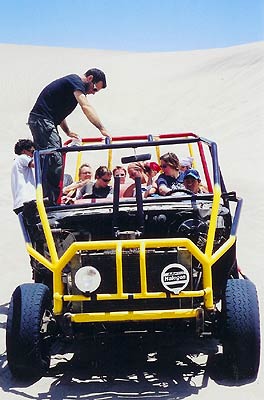
In its place were braced metal pipes, soldered together in a way that outlined the shadow shape of the truck in strong skeletal lines. Interlaced within these metal barriers were three bench seats whose torn orange plastic covering adequately complimented the paint job. There was no hood, no seatbelts, no windshield, and no way I was going to miss out on climbing the dunes on a leftover vehicle from Mel Gibson’s "Mad Max" movies. We threw our boards into the netted trunk of the buggy and slipped between the bracing bars and planted ourselves on the cushiony orange seats of our post-apocalyptic chariot.
Our driver turned on the ignition and the Franken-Ford roared to life without a key, just a turn of the key slot. We let the monster grumble for a few minutes, as gasoline coursed through its heart. The lion’s roar of the engine turned to a steady growl, and our driver coerced it forward by forcing gasoline down its gullet.
We picked up speed quickly and barreled down the sand-covered asphalt toward the town’s largest dune. After only thirty seconds, we were faced with the frozen wave, losing and rebuilding itself with each breath of wind. We circled around it searching for a channel. We rose quickly up the shortened face of an encountered sand channel and followed the tire-treaded markings of dune buggies before us. We rode the sand swells deep into the dunes until the town of Huacachina lay on shore beyond towering dunes that obscured our sight. We were surrounded by sand whose fine bodies threw themselves about under our deeply treaded rubber tires. Slight licks of wind caught loose grains in their sighs and pushed them running along the wind-wrinkled ground. Small ripples, like wind-kissed water in a tide pool, etched themselves onto the top layers of the pulverized rock.
The beast we rode on became more daring, carrying us up steep faces that seemed more like 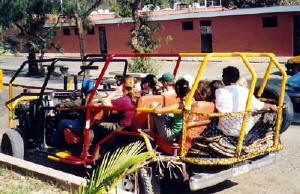 walls than angled inclines. I looked to our driver, handling the beast without a smile, sunglasses pushed hard against his face, and his left arm resting on a metal beam that stood in remembrance of the door. I looked to the control panel. Speedometer: stuck at zero, not even a hair’s width of an increase. The RPMs bounced along with the terrain of the dunes. Occasionally they bounced into the red, other times they stood as silent and stoic as the driver himself. I then noticed the buggy was driving in "park." I had seen the driver fiddle with the gearshift of the automatic, but the panel always read "park." I removed my attention from the endless rise, fall, and flat-out within the dunes, and focused on his shifting. When we approached a dune he would jerk the gearshift down causing no movement on the panel, but the engine would rumble quicker. When we crested the dune he would jerk the gearshift north, still no change in the panel.
walls than angled inclines. I looked to our driver, handling the beast without a smile, sunglasses pushed hard against his face, and his left arm resting on a metal beam that stood in remembrance of the door. I looked to the control panel. Speedometer: stuck at zero, not even a hair’s width of an increase. The RPMs bounced along with the terrain of the dunes. Occasionally they bounced into the red, other times they stood as silent and stoic as the driver himself. I then noticed the buggy was driving in "park." I had seen the driver fiddle with the gearshift of the automatic, but the panel always read "park." I removed my attention from the endless rise, fall, and flat-out within the dunes, and focused on his shifting. When we approached a dune he would jerk the gearshift down causing no movement on the panel, but the engine would rumble quicker. When we crested the dune he would jerk the gearshift north, still no change in the panel.
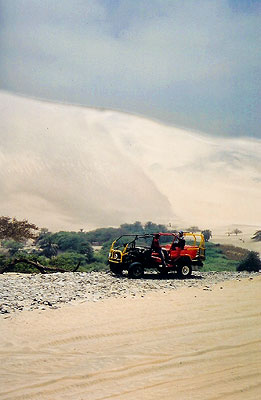 As we continued our roller coaster ride through the early morning dunes, the hovering morning clouds began to disperse. I felt slight tickles of water hitting me lightly on the cheek and lips. At times, when I would shout something to Virgil, a New Yorker who shared the front bench seat with the driver and me, the drops would find their way into my open mouth.
As we continued our roller coaster ride through the early morning dunes, the hovering morning clouds began to disperse. I felt slight tickles of water hitting me lightly on the cheek and lips. At times, when I would shout something to Virgil, a New Yorker who shared the front bench seat with the driver and me, the drops would find their way into my open mouth.
Was rain falling? Would our trip be detoured by muddied sand? Riding where the front passenger seat would have been, I stuck my arm out of the encasing and felt for more drops. None fell on my hand, just my face. Right then I figured it out. I shut my mouth tightly and made sure my sunglasses fit smartly against my face. Now I knew why the driver never smiled and never talked.
Protruding from the hoodless engine in front of me stood two exhaust pipes. Although I’m sure carbon monoxide was churning out of the black rods quicker than at a NASCAR race, our open canopy and constant speed blew most of it away from our lungs. However, condensation from a hot engine and cool moving air hung at the mouth of the exhaust. When the droplets became heavy enough they would free themselves from the lips they clung to, and find their way onto mine. Exhaust water had been pelting my face like pixie slaps. I tried hurriedly to remember if I had welcomed any into my mouth, thinking they were raindrops and rode the rest of the way with an extremely tight-lipped smile.
When the engine stopped we found ourselves at the top of one of the dunes. Our instructor, who had been riding with us, produced a bag of floor wax and gave each of us two squirts on the slick side of our boards. He told us to spread the wax over the surface of the board with out hands. What he didn’t tell us until I asked was that the wax wouldn’t come out of our clothes. Everyone stopped spreading the orange wax simultaneously and looked to their shirts and pants. Too late, we had all unknowingly stained some section of our clothing. I asked for more wax to make my white shirt uniformly orange, but was given only giggles.
Once we had waxed our boards, we sat in a line along the sand dune ridge, listening intently on how not to simply fall head over ass down the face of the fixed wave. "Strong foot like dis!" shouted our instructor as he faced the sand wall and headed down the dune at a forty-five degree angle. A few yards down he yelled back up at us, "To stop you do dis!" and he turned his board parallel with the dune, leaning into the wall with his knees. After looking up at us one last time he goaded us and said, "OK! Leet’s go!" With that, he cut a swath down the dune side spouting sand from the back of the board as he went. We all looked at each other for a second, strapped our feet in tight to the Velcro bindings, and looked down the steep face. We smiled and shrugged as we pushed off and tried to steady ourselves on our floor-waxed boards. Most of us stumbled more than once, inviting sand into body crevasses and clothing hems. I made it half way down with little difficulty then found the Achilles’ heel of this sport. Floor wax was not meant to be slathered onto the bottom of a wooded board like sunscreen then scraped off in deep and finely grained sand. Half way down the slope, our boards lost all the slickness that protected them from the fun-hindering traction. I hopped down the mountain hoping my weight would give my board momentum. It was not to be. I stopped my crazed hopping and un-strapped myself from the board as I ran down the rest of the face. Behind me, most of our group still flopped on their backs, bellies, and butts as they eked down the side. Eventually they too un-strapped themselves, held onto their boards, and walked the rest of the way.
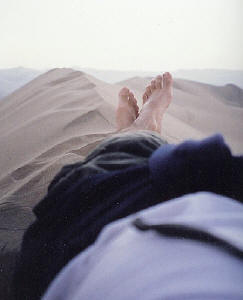 We went to five more dunes, each time throwing our boards into the back of the beast and rumbling to the top. With each descent I felt more comfortable on the board. I sped up my run and ran out of wax closer and closer to the bottom. I learned that speed is not just a way to test my testosterone on the side of a sand dune. It is also necessary to plan on getting down without walking.
We went to five more dunes, each time throwing our boards into the back of the beast and rumbling to the top. With each descent I felt more comfortable on the board. I sped up my run and ran out of wax closer and closer to the bottom. I learned that speed is not just a way to test my testosterone on the side of a sand dune. It is also necessary to plan on getting down without walking.
By the end of the day, sand had replaced our scalps and the gums between our teeth. I scratched my head and found my fingernails filled with sand. Our gritty smiles crunched under our words as we laughed and talked about our runs. On the ride back to our hostel however, as everyone in the back of the dune buggy conversed in competing amplification with the engine, my companions and I in the front seat wore tight-lipped smiles, feeling the sting of exhaust water on our faces, and hoping we would have a chance to do it all again.
